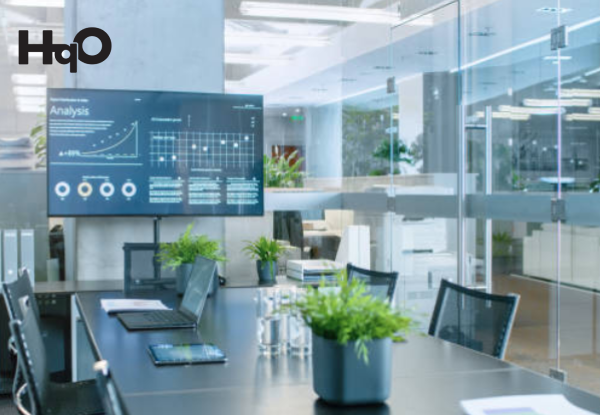A lot of people don’t realize that commercial real estate (CRE) has become one of the most tech-savvy industries operating today, as evidenced by recent innovations that professionals are making use of on a daily basis. Today’s popular office space technologies include everything from building management software to tenant engagement apps for every need.
Artificial intelligence is playing a more important role in property and facilities management all the time. For example, it can help analyze critical building functions and layouts, as well as provide invaluable information on HVAC systems, lighting solutions, and more to help people make better and more informed decisions to optimize building performance moving forward. Technology is even easing pain points associated with where and how the modern workforce works, allowing them to stay connected to and engaged with an office’s culture even while they’re physically out of the building.
Thus, leveraging a building maintenance program is one that brings with it a host of unique opportunities that most commercial property teams simply cannot ignore.
The Modern Way to Upkeep Facility Management
At its core, building maintenance management refers to all of the processes and procedures that are needed to help guarantee that the systems of a building continue to perform — both as they were originally designed and well after construction. You’ve also likely heard this referred to by terms like upkeep facility management, among others.
Generally, this includes both those preventative and predictive maintenance and repairs that are needed to keep a building operating at its best. Preventative maintenance can include building-specific requirements that need to be planned, scheduled, and executed to stop small problems before they become bigger and more expensive down the road. Predictive maintenance is all about correcting aspects of the building that have already degraded prior to the point of “significant deterioration.” Collectively, this approach allows building operators to reduce capital repairs, reduce unscheduled repairs, extend the life of their buildings, and more. It also helps provide their customers with safe, functional systems and environments that meet their original intent — which is obviously the most important goal of all.
A building maintenance app or some other type of upkeep software becomes an invaluable tool to that end. A computerized maintenance management system, otherwise known as CMMS software, acts as a single source of “truth” for all maintenance information that empowers building operators as they go about their preventative and predictive maintenance. This type of maintenance management software lets managers automate the process of creating, scheduling, assigning, and even monitoring maintenance work orders for their facilities — all so that they can be sure that important tasks are being completed as quickly as possible. The best CMMS software also frees up as much of their valuable time as possible so they can focus on those matters that really need them.
This type of property management software can use historical and real-time data to help building managers not only identify risks like lost revenue and liability, but it can also help them make better decisions in terms of their overall optimization of resources. It can also shed light into valuable KPIs like asset life expectancy, labor costs, and energy management. Finally, CMMS software allows teams to manage outside vendors and communicate work orders automatically, all so that people are informed quickly and able to start taking action immediately.
Property Management Software’s Role in Data-Driven Decision Making
Perhaps the biggest advantage of these types of property management maintenance tools is that they allow building managers to make more data-driven decisions than ever before. Upkeep asset management software allows those in charge to collect more information on their buildings (and their end-users). They’re able to dive deep into labor and cost-related data for specific locations, identifying an at-risk area that may have otherwise gone undiscovered. They can see detailed information about the types of recurring issues they face so that they can get to the bottom of what is actually causing them. Property maintenance management software is even a great way to set up automatic preventative maintenance notifications for regularly occurring tasks, all to make sure that your programs are actually being followed by employees on-site.
All of this allows them to optimize their buildings and amenities while also learning more about the offerings they need and — more critically — the ones they don’t. If you have comprehensive data regarding how your facilities are actually being used, you can see which amenities hold the most value to your building population — which then helps justify the cost of actually maintaining them over time. If a particular asset isn’t nearly as popular with tenants as you thought it would be, it’s likely costing you money. Therefore, those amenities can be eliminated and that space (not to mention those funds) can be funneled back into other aspects of the building where they can make a bigger impact.
By giving you a complete overview of your ongoing costs, property management maintenance tools can also be a great way to identify opportunities to reduce energy costs. You can see exactly which HVAC units are constantly experiencing issues, thus using far more energy than they’re worth. At that point, you can see which units you should repair versus which you should outright replace — thus capitalizing on an opportunity to improve the energy efficiency of your entire building that may have otherwise gone undiscovered.
The Future of Building Maintenance
In the end, building maintenance management software is an opportunity to work “smarter, not harder” — and it couldn’t have come along at a better moment. To say that the commercial real estate industry experienced a significant amount of disruption in the last year is, at this point, an understatement. By acting as a one-stop-shop for all the data and real-time insights into facility efficiency you need, property management software offers you more than just a chance to make smarter and more informed decisions every day. It helps maintain a modern, efficient, and profitable office portfolio while also giving you a competitive edge in the market.




